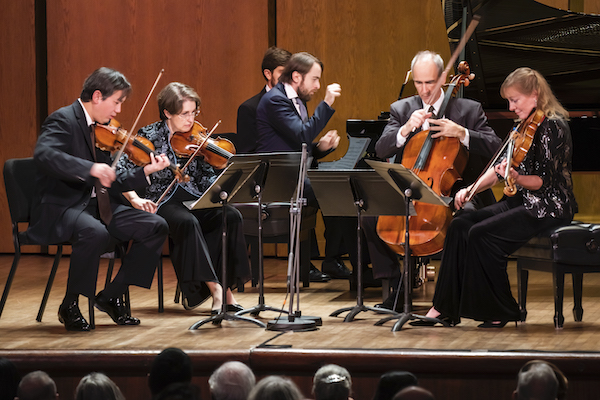Trifonov quintet makes strong NY debut with Philharmonic Quartet

Standing tall in the performance arena these days, Daniil Trifonov has also been thinking bigger than most other pianists who compose. Not content with crafting fizzy encores or even serious preludes and etudes, he has gone straight for the large-scale genres.
On Sunday afternoon, undaunted by the mixed critical notices his Piano Concerto received at its Carnegie Hall unveiling two years ago, Trifonov brought an ambitious new piano quintet to the New York Philharmonic Ensembles series at the 92nd Street Y.
In its New York premiere, the Quintetto Concertante had the benefit of the composer’s passionate presence at the piano and the superb teamwork of four first-chair Philharmonic musicians: violinists Frank Huang and Sheryl Staples, violist Cynthia Phelps, and cellist Carter Brey.
Russian greats such as Rachmaninoff and Prokofiev not only provided the model for the kind of career this young virtuoso seems to be aspiring to, but also seem to have inspired much of the content of his compositions. But if Trifonov’s style can be considered retro, his musical ideas often proved fresh and attractive in this quintet, composed last year.
The work’s title appeared to promise pyrotechnic pianism in the manner of those Russian masters’ concertos, but instead Trifonov stuck pretty much to the quintet model of Brahms, Franck, and Shostakovich—piano-driven to be sure, but more a rich collaboration than a virtuoso showpiece.
The piece opened in the most unshowy manner imaginable, marked Grave but also grave in the English sense—strings playing non vibrato, the young pianist hunched over his instrument like a keyboard Raskolnikov. From these morose beginnings arose a movement of marked contrasts, playful and grandiose by turns, as intensely chromatic harmonies gave way to a string chorale with brusque piano interjections.
A brief, sarcastic Allegretto scherzando evoked circus music and Debussy’s Golliwogg in a stomping waltz. The pianist kept it crackling with ironic panache.
The three-to-a-bar meter persisted but slowed to Larghetto in the next movement, with twisting, chromatic string lines over full chords in the piano. The most deferential of virtuosos, Trifonov was if anything too self-effacing in his expressive duets with individual string players.
The music accelerated without a break into the Allegro con fuoco finale, its cool “fire” mostly light and whimsical with slower, more tender interludes. A jazzy fugue delighted the ear with its bitter wit.
Then, as if remembering to be “concertante,” the music swelled unexpectedly into an extended, near-exact quotation of the massive first-movement cadenza from Rachmaninoff’s Third Piano Concerto. After this thank-you note to his mighty precursor, Trifonov drove on to some very final-sounding big chords for the full ensemble, only to make it all evaporate amid soft trills at the end.
The audience clearly enjoyed the ride, calling the composer and the other players back to the stage several times. They may also have hoped for a piano encore, but Trifonov wisely demurred on that.
Trifonov’s piece was preceded in the program’s first half by polished, rather down-the-middle performances of Mozart’s Quartet in G major, K. 387 and Ravel’s String Quartet by the four Philharmonic players.
These orchestral leaders are among the most experienced ensemble players around, wonderfully alert to intonation, balance and blend. Still, although they billed themselves as the New York Philharmonic String Quartet, it was clear on Sunday that quartet playing is not their day job, and one would have liked these expert renderings to probe more deeply beneath the surface than they did.
Highlights of the Mozart included tender dialogue and a venture into pianissimo misterioso in the Andante cantabile movement, and zesty execution of the “Jupiter” Symphony-style fugal finale.
The Ravel was distinguished by suave, silky tone throughout and spiffy dance rhythms in the pizzicato scherzo. The first movement had a particularly well-gauged ebb and flow.
The 92nd Street Y presents Orpheus Chamber Orchestra, with violinist Carolin Widmann in music for wind orchestra by Mozart and Weill, 8 p.m. Saturday. 92Y.org; 212-415-5500.



Posted Dec 03, 2019 at 10:43 am by Roman Markowicz
Listening to the cadenza-like fragment in the final movement of the Quintetto Concertante I was also reminded of Rachmaninov Pno Cto No.3, EXCEPT that what we’ve heard from the stage of 92 Str Y and what reminded us of Rachmaninov was the cadenza in the 3rd movement of his concerto. Just a little correction to the otherwise excellent and insightful review by Mr.Wright. And the quiet ending? What about the Prokofiev Sonata in F minor for Violin and Piano op.80? Almost verbatim…